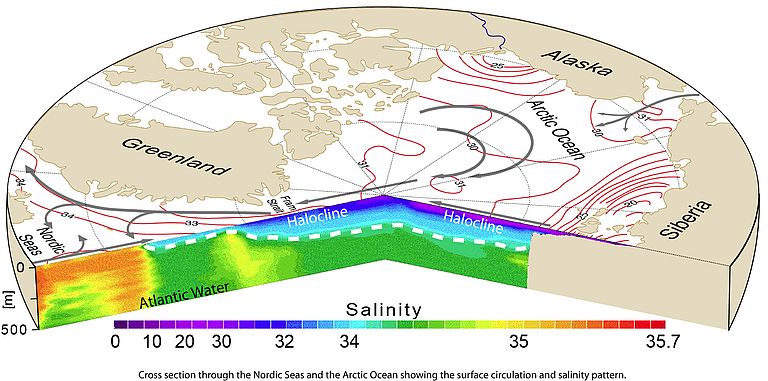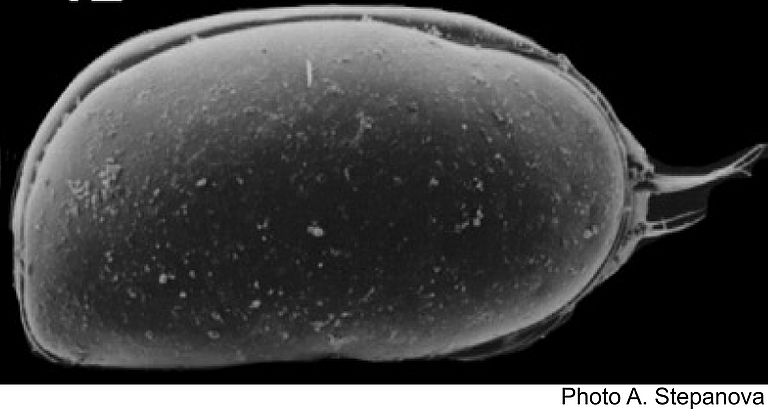A warmer Arctic Ocean during ice age times
Today’s Arctic environment is under tremendous threat due to global warming. Special attention has been given to the strong reduction in sea ice cover during recent summers. The sea ice in the Arctic is the top layer of the ‘halocline’, a 200-300 m thick layer of low salinity. The low salinity in this layer is due to repeated annual melting and freezing processes as well as freshwater input from the large rivers flowing into the Arctic Ocean, particularly from the Siberian continent. But the halocline is also very cold, close to -2° C. In contrast, below the cold halocline the water is about +1° C due to warmer and more saline waters flowing into the Arctic Ocean from the North Atlantic.
Scientists from the US Geological Survey, Stockholm University, Duke University and the Paleontological Institute in Moscow have published together with researchers from the Academy of Sciences, Humanities, and Literature Mainz (c/o GEOMAR | Helmholtz Centre for Ocean Research Kiel) a new study in Nature Geoscience entitled "Deep Arctic Ocean warming during the last glacial cycle." The researchers reconstructed the intermediate and deep Arctic Ocean temperature history during the past 50,000 years using geochemical proxy techniques and sediment cores from across the central Arctic Ocean. They have utilized tiny microfossils, so-called mussel shrimps (ostracodes). “These ostracodes usually live on the sea floor, and because they have valves made of calcite, the measured Mg to Ca ratio can be used to estimate past temperatures of the bottom water” says Dr. Bauch, who has worked with Drs. Cronin of USGS and Dwyer of Duke University to use this fossil group to reconstruct bottom water conditions.
Results show that in the last ice age, within the time span from about 50,000 and 11,000 years ago, the central Arctic Basin between 1,000 and 2,500 m water depth was occupied by a water mass that was 1–2° C warmer than in the modern Arctic. Deep Arctic warming peaked during or just before large millennial-scale climate reversals that characterize this period. The finding is therefore so interesting because “one would expect to see quite the contrary since in a glacial time, temperatures in the ocean were usually colder than today anywhere “ says Dr. Spielhagen. The opposite situation was actually found for historical times, as was recently published in the journal Science. For the Fram Strait, where substantial Atlantic water flows into the Arctic Ocean today, “our reconstructed temperatures indicate an increase over the last 150 years” says Dr. Spielhagen.
The new study now also shows modelling results suggesting that the deep warming could result from a decrease in the influx of fresh water to the Arctic Ocean during the last glacial period, which would cause the strong salinity gradient in the halocline to deepen and push the warm Atlantic layer into intermediate depths. The researchers concluded that the Arctic Ocean has previously unrecognized sensitivity to climate changes over multiple timescales. This is surprising because “only 20 years ago people thought of the polar glacial ocean as a cold and perennially ice-covered region but with rather stable environmental conditions. “ says Dr. Bauch. There is growing evidence now from marine sediment records of the Nordic Seas that “the deep water temperature in that North Polar region was actually warmer than today during a glacial period”. This was likely caused by a subduction of the inflowing Atlantic water implying that “the meridional overturning circulation never stops, not even in an ice age period” says Dr. Bauch who has recently published a study on the subject in the journal Geophyscial Research Letters.
Reference:
Cronin, T. M., G. S. Dwyer, J. Farmer, H. A. Bauch, R. F. Spielhagen, M. Jakobsson, J. Nilsson, W. M. Briggs Jr, A. Stepanova (2012): Deep Arctic Ocean warming during the last glacial cycle. Nature Geoscience, http://dx.doi.org/10.1038/NGEO1557
Contacts in Germany:
Jan Steffen (GEOMAR, Communication and Media), +49 431 600 2811, jsteffen(at)geomar.de




